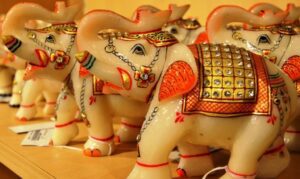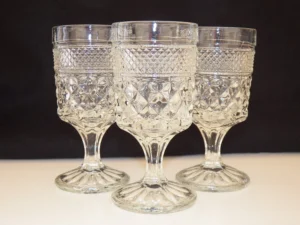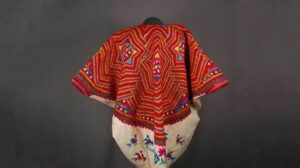Indian Handicrafts
Indian handicrafts are the composite form of all those items whose workmanship is done by human hands, many states in India have their own Indian handicrafts which shows skill and artistic proficiency. Artists use their skills to create a variety of objects that can be decorative or functional. 
This is a unique type of Indian handicrafts in which the objects are completely handmade without the use of any machines. People in India use Indian handicrafts not only as a means to earn their livelihood but also as an art to be preserved for generations to come. Indian handicrafts are of special importance among tribal and rural communities who depend on them for their livelihood.
Glassware is an Indian handicraft in Indian art and culture
The first reference to the making of ear f is found in the Indian epic Mahabharata, physical evidence gives no indication of the mind of glass in the early Harappa civilization. The first physical evidence is found in the form of beautiful glass beads from the painted pottery culture of the Ganges valley.

The word used for glass in the Vedic text called Satpath Brahmana is glass or kunch. We have found archaeological evidence of glass industry in Brahmpuri and Kolhapur in Maharashtra. Which were in operation between 2 BC and 2 AD and lenticular beads were manufactured here. The glass industry also entered a field of optical lenses We find references to glasses in the cultural treatise Vayasanyogcharitra In the southern part of India.
we have found archaeological evidence of glass from the Chalcolithic strata Maski in the Deccan. Other sites that have witnessed the case are Aahar Rajasthan, Hastinapur and Uttar Pradesh, Airan and Ujjain, Madhya Pradesh etc. During the mediaeval period the Mughals patronized the art of glassware and used them as decoration in their monuments such as the Sheesh Mahal, glass hookahs, scented boxes or other glass objects such as irdaan and engraved glass etc. which were mainly made for the Mughals.
Indian handicrafts the second center of glass in Uttar Pradesh is Saharanpur, where panchkhora or glass toys are made for children, in Patna also a strange type of glass ornamental mind called Tikuli is constructed. It is the craft almost lost in industrialization, still made by the Santhal tribes of Bihar. The Tikuli art of present-day Bihar has also been made on shining hard boards to revive the look of art in contemporary and modern times.
Handicrafts on clothes in Indian art and culture
Tie and die (bandana and Rangana)
Indian handicrafts the technique of tying and dyeing brings beautiful designs on clothes, there are many such techniques in India. One of the self-important arts is the art of Badani, it is also known as the technique of tie and dye in English.
Indian handicrafts There is evidence of the use of this ancient technique that is also popular in Andhra Pradesh and Tamil Nadu. It is also called the resist dyeing process where the tied parts do not paint the color in which the fabric is soaked.

The tie and dye technique of a special car that creates wavy or wave-like patterns in clothes is called Lahariya, it is made in Jaipur and Jodhpur.
Another type of tie and dye, known as the resisting method of dyeing, is called ikt, in this growth Indian handicrafts, the weaving threads are dyed repeatedly before the fabric is woven. The major centers of this activity are Telangana, Odisha, Gujarat and Andhra Pradesh.
this is an Indian handicraft Prominent among these are Kalamkari, which uses the art of casualty printing of cloth using dark vegetable dyes, which is prevalent in Andhra Pradesh, West Bengal and Odisha. A beautiful dirt of fabric decoration is called Pattikalan,
in which one end of the cloth is melted, seepage is received from the wax, after which multi-colored plaques are dyed at low temperature to make sarees and dupattas. Bati art is famous in Madhya Pradesh and West Bengal.
Pat is an art that emerged from Indonesia in India some of the techniques of fabric patterns came through trade routes. For example, Tanchoi silk sai is said to have originated in China, it must have come to Surat in Gujarat through the trading community.
Tanchoi silk zari work in Varanasi is a specialty of weavers, this weaving resembles a fine miniature painting, another ancient art Jamdani in which separate muslin weaving is done with opaque patterns on a transparent background.
Embroidery Art is an Indian handicrafts
The art used at the V levels is unique in creating a filled design using thread or wood now ones, this art is called embroidery art.

It is made using gold, silver, silk near threads on the fabric with the help of a needle. There are many types of embroidery arts.Embroidery like Peepli work is prevalent in the village of Peepli in Odisha. It is a type of piece made of colored cloth containing embroidery that is sealed together to form a section. They use this technique to make beautiful lamps.
in Indian handicrafts Another famous technique called phulkari which means economic flower making is used in this process to create colorful floral member patterns on fabric. this Indian handicraft It is produced in Punjab, Haryana and Delhi.
It uses silk thread to embroider on green fabric to create floral patterns, gold thread is used for cutting other techniques like Rajasthan and to create peepli-like patterns on the fabric. Khandela and Jaipur is inside two famous for Zari work.
Karchaubi related to zari is another technique made by sealing flat stitches over cotton to make raised zari like a metal thread pattern Chikankari embroidery defines the culture and cloth making process of Lucknow.
It has white forward used to make flowers and beautiful patterns, cotton fabric, cotton, muslin, cotton fabric, polyester and fine fabric can be done on many types of fabric like Kashmir Kasida embroidery is famous for fine artisans.
It is done on the famous Kashmiri shawl. Banarasi zari work is famous for its silver and gold medium work on sarees. They have floral forms and silk sarees are commonly used It takes two to eight weeks to make. During the medieval period, royal dresses and solo in the courts of Muslim rulers.Himru material was used for royal dress and solo in the courts of Muslim rulers during the medieval period.
It is made in Aurangabad. Sai Maheshwari sarees of Sai Maheshwari yarn are also used in the Shahi Maheshwari sarees of Madhya Pradesh, they are embellished with golden zari work. They are famous for their reversible edges which can be worn from both sides.
The Chamba handkerchiefs of Himachal Pradesh, which have the influence of Chamba Pahari painting, are subtly sparked in yellow and saffron colors with objects from Krishna’s stories, used as an object of gift during marriages.
Indian handicrafts These handkerchiefs depict the entire nature including the trees and flowers. Kutch in Gujarat is known for the embroidery of mirror work called lead in which small pieces of mirror are fixed into the fabric using wavy fine bakhia and sartan stitching.
The hood worn by women on auspicious occasions like the dispute in Manipur is embroidered with delicate coral silk thread in dark colors on a traditional sole. The folk embroidery of Karnataka is created in a horizontal stitch in Kasuti. Handwoven belongs to the Chalukya period.
conclusion
Indian handicrafts are a treasure trove of artistic ability, tradition, and culture that have been passed down through the ages. Every Indian handicraft object, from colorful textiles and exquisite pottery to delicate jewelry and elaborate woodwork, reveals something about the many regions and talented craftspeople of India.
Indian handicrafts demonstrate the strong bond between the artisan and their craft, serving as more than just products—rather, they are embodiments of India’s legacy. Indian handicrafts are treasured both in India and around the world as a celebration of creativity, sustainability, and timeless beauty, whether it’s the exquisite marble inlay of Agra or the fine embroidery of Kashmir. Indian handicrafts are very famous
